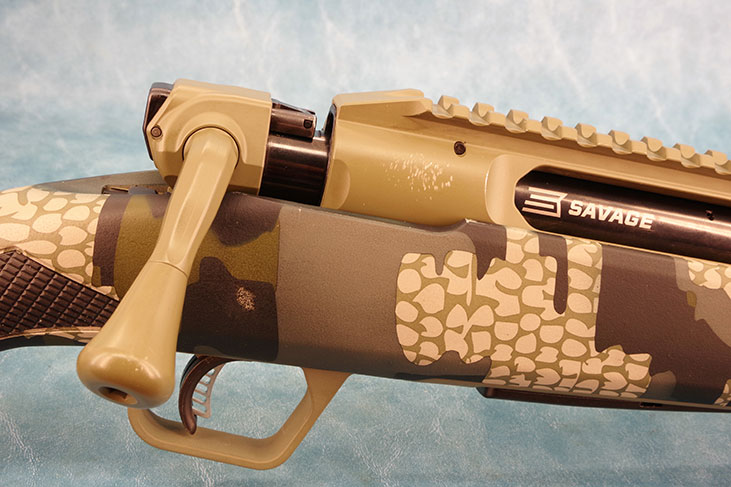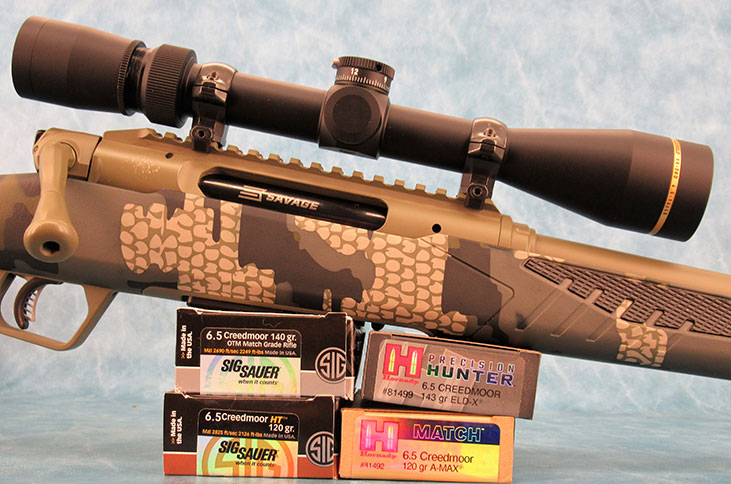Guns and Ammo – Savage’s New Straight-Pull Rifle Is Fast And Accurate
It’s taken so much longer than I thought it would, but finally an American arms manufacturer has introduced a straight-pull centerfire rifle.
I’m talking about Savage’s Impulse. It will test the waters and let us know whether America’s hunters and shooters will embrace a departure from convention, because thus far the mainstream has been reluctant to stray from the `98 Mauser-type turnbolt rifle.

I’ve been a fan of straight-pulls ever since the Blaser 93 was introduced here in the mid-`90s. Since then, other gun-makers have embraced the idea. Merkel has its RX Helix, Blaser’s second gen R8, Mauser’s M-96, Roessler’s Titan, Anschutz’s 1727, Heym’s SR-30 and Browning’s Maral. All are made in Europe and popular with hunters there. And why shouldn’t they be?
SPEED KILLS
Straight-pulls are second only to a semi-autos in terms of speed because they require only two motions to cycle the action rather than the four needed for a conventional bolt gun. Then there’s the fact that the pull-push action disturbs the gun less so it’s faster to get back on target — a real attribute in running boar competitions. Also, the extraction stroke (pull) is done with stronger muscles than those used to cycle a turnbolt. With a sticky case, raising the handle on a convention bolt action with the gun shouldered can be impossible; that’s why most hunters lower the gun to reload.
All that said, I could never understand why at least one U.S. gun-maker hadn’t tested the waters with a straight-pull centerfire rifle. Well, that’s not quite true. Browning did just that in the mid-`90s with its European-made Acera. But it was given such a ho-hum reception here that it was withdrawn from the market after a couple of years. But even today, it remains the fastest-cycling of all the straight-pulls, a fact not lost on European hunters. It’s doing quite well there as the Maral.
Now, with Savage’s Impulse we’ve turned the page and have a domestically produced straight-pull centerfire rifle. The example sent us for review was the Big Game model (one of three, the others being the Predator and Hog Hunter), chambered in 6.5 Creedmoor, the highest profile cartridge of the past five years. Out of the box, the test gun weighed at 1.4 ounces shy of 9 pounds.
The impulse is built on a massive aluminum receiver rather than a steel receiver. This is made possible by the fact that the locking system engages a barrel extension rather than the receiver. Both it and the barrel sport an attractive Hazel Green CeraKote finish. So does the one-piece bottom metal unit that integrates the trigger guard bow and magazine frame. As for what is being touted as a revolutionary new locking system, Heym’s SR-30 pre-dates it by some 23 years, a fact that I’ve not seen mentioned in the reviews I’ve read.

Simply stated, lock-up is achieved by wedging six ball bearings (same as the Heym), held captive in sockets at the head of the bolt, outward to where they engage an annular abutment groove in the barrel extension.
On the initial rearward pull of the handle, the wedge is withdrawn, allowing the bearings to lower and disengage. The full movement of the bolt handle from the action being locked to unlocked is an arc of about 40 degrees, and it takes quite a tug to initiate it.
With the bolt removed, one can see on the recessed bolt face the absence of the familiar plunger-type ejection system. Instead, a slot on the left side of the bolt face betrays mechanical ejection by a static arm housed in the left side of the receiver bridge. The 2-position safety is located in the floor of the receiver tang, just as it is on Savage’s 100-series bolt-action rifles. But at the rear of the handle unit, a square, pivoting pushbutton allows the action to be cycled with the safety engaged.
Despite its obvious similarity to the Heym, Savage claims 13 patent-pending features for the Impulse, among them an ambidextrous bolt handle. Yep, if you’re a southpaw you can switch the handle to the left side. Not only that, you can change the position of the handle to any one of five settings. Doing so doesn’t change the arc, but the reach to the handle does, so you can find which of the five positions best suits you. These are two really cool features.
The bolt handle’s grasping ball can also be changed.
The receiver’s bedding surface is flat and on one plane its entire length. Up top is an integral 16-position Picatinny rail, so the scope mounting options are endless. Naturally, Savage has adapted its excellent AccuTrigger for the Impulse, and it comes from the factory set at 3 pounds.
The rather stout 22-inch barrel is mated to the receiver using Savage’s lock-nut system, which simplifies and speeds up the headspacing procedure. Sandwiched between the lock nut and receiver face, is a washer-type recoil plate. When I said the barrel is rather stout, it starts out at 1 inch in diameter and straight-tapers to .75 of an inch at the 5/8×24-thread muzzle, which is fitted with a protective cap. Six 12 1/2-inch flutes begin some 6 inches from the barrel lock nut and end 2 1/4 inches from the muzzle.
The barreled action resides in an AccuStock finished in Verde camo, and although it’s adjustable for comb height and length-of-pull, it was just right for me as it came from the box with an LOP of 13 3/4 inches and with the lowest of five comb options installed.

The four-round magazine is a sheet metal affair that stores cartridges in a staggered row but feeds from a central position perfectly aligned with the chamber. I do wish they had gone with a unitized polycarbonate box instead of stamped sheet stock; they are so superior in every way. Anyway, the box does fit flush with the belly of the stock, and that’s good. And it takes a good tug on the release lever to free it. Also good.
To ready the Impulse for the range, we mounted one of Leupold’s new VX-3HD 4.5-14×40 scopes with a Boone & Crockett reticle, my favorite reticle because it provides all the features a hunter needs without a lot of clutter in the field-of-view.
I’ve used 30mm scopes for most of my gun testing over the last decade. I had almost forgotten how delightfully light and compact a 1-inch scope can be! This little gem weighs but 13.4 ounces and is 12.7 inches long. Depending on the specific caliber and load, a list of three “trajectory families” as it were, is included with the scope that correspond to aiming points at 200-500 yards or 300-600, depending on a zero range of 200 or 300 yards, respectively.
This system of hash marks on the lower reticle arm is fairly accurate, but there’s no substitute for zeroing in at the suggested range, then shooting at the farther distances to determine the exact relationship of your actual point of impact to the respective hash mark. My range goes to only 300 yards. With 140- and 143-grain loads zeroed at 200 yards, using the first hash mark below center on a 300-yard target, I was within 1.5 of an inch of my aim point with both loads.
As tested with the Leupold aboard, sitting in Millett rings, the field-ready rig weighed exactly 10 pounds. A mountain rifle, this ain’t!
We had several brands and loads of 6.5 Creedmoor on hand, and we figured four should give some idea as to the accuracy potential of the test gun. We used Hornady’s 143-grain Hunter ELD-X, Sig-Sauer’s 140-grain OTM Match, Hornady’s 120-grain A-MAX and Sig-Sauer’s 120-grain HT.
All four loads turned in at least two sub-MOA groups out of five 3-shot groups fired with each. Hornady’s 120-grain A-MAX took the prize, averaging .83 inches, with Sig’s 140-grain OTM Match load not far behind at .98, discounting one flier with each aggregate.

The Impulse performed without a hitch in firing over 90 rounds. The action was silk-smooth but required a bit more effort to cycle than the European straight-pulls I’ve reviewed over the years, and I’ve shot them all.
Charging the magazine is a bit of a pain. As with all magazines with tilting followers that need you to slide each round back under the feed lips. But that’s just a minor inconvenience. All in all, it’s a very solid gun, accurate and lightning quick to reload.
Initially, the Impulse is being offered in 6.5 Creedmoor, .308 Win., .30-06 and .300 Win. Mag., with more calibers to be added. The Impulse carries an MSRP of $1,449 in all calibers. www.savagearms.com–Jon R. Sundra

